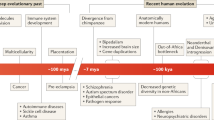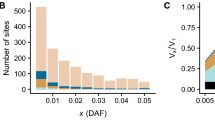Abstract
Paul Griffiths and John Matthewson argue that selected effects play the key role in determining whether a state is pathological. In response, it is argued that a selected effects account faces a number of difficulties in light of modern genomic research. Firstly, a modern history approach to selection is problematic as a basis for assigning function to human traits in light of the small population sizes in the hominin lineage, which imply that selection has played a limited role in shaping these genomes in the evolutionarily recent past. Secondly, determining both the genetic basis of disease and selective histories of the various alleles involved may be experimentally intractable. Thirdly, the existence of “selected disorders” is well supported, and yet on the other hand many other common diseases may not reduce evolutionary fitness. In summary, the biological ends promoted by natural selection, as best modeled in recent research, do not adequately ground a concept of dysfunction that aligns well with the interests of human health.
Similar content being viewed by others
References
Alföldi J, Lindblad-Toh K (2013) Comparative genomics as a tool to understand evolution and disease. Genome Res 23:1063–1068. doi:10.1101/gr.157503.113
Biswas S, Akey JM (2006) Genomic insights into positive selection. Trends Genet 22:437–446. doi:10.1016/j.tig.2006.06.005
Boorse C (1977) Health as a theoretical concept. Philos Sci 44:542. doi:10.1086/288768
Boyko AR, Williamson SH, Indap AR et al (2008) Assessing the evolutionary impact of amino acid mutations in the human genome. PLoS Genet 4:e1000083. doi:10.1371/journal.pgen.1000083
Cooper GM, Shendure J (2011) Needles in stacks of needles: finding disease-causal variants in a wealth of genomic data. Nat Rev Genet 12:628–640. doi:10.1038/nrg3046
Cummins R (1975) Functional analysis. J Philos 72:741–765. doi:10.2307/2024640
De Gobbi M (2006) A regulatory SNP causes a human genetic disease by creating a new transcriptional promoter. Science 312:1215–1217. doi:10.1126/science.1126431
Dudley JT, Kim Y, Liu L et al (2012) Human genomic disease variants: a neutral evolutionary explanation. Genome Res 22:1383–1394. doi:10.1101/gr.133702.111
Dunham I, Kundaje A, Aldred SF et al (2012) An integrated encyclopedia of DNA elements in the human genome. Nature 489:57–74. doi:10.1038/nature11247
Galtier N (2016) Adaptive protein evolution in animals and the effective population size hypothesis. PLOS Genet 12:e1005774. doi:10.1371/journal.pgen.1005774
Garrigan D, Kingan SB, Pilkington MM et al (2007) Inferring human population sizes, divergence times and rates of gene flow from mitochondrial, X and Y chromosome resequencing data. Genetics 177:2195–2207. doi:10.1534/genetics.107.077495
Gazave E, Ma L, Chang D et al (2014) Neutral genomic regions refine models of recent rapid human population growth. Proc Natl Acad Sci USA 111:757–762. doi:10.1073/pnas.1310398110
Gluckman PD, Hanson MA (2008) Developmental and epigenetic pathways to obesity: an evolutionary-developmental perspective. Int J Obes 32:S62–S71. doi:10.1038/ijo.2008.240
Godfrey-Smith P (1994) A modern history theory of functions. Noûs 28:344. doi:10.2307/2216063
Graur D (2017) An upper limit on the functional fraction of the human genome. Genome Biol Evol 9:1880–1885. doi:10.1093/gbe/evx121
Graur D, Zheng Y, Price N et al (2013) On the immortality of television sets: “function” in the human genome according to the evolution-free gospel of ENCODE. Genome Biol Evol 5:578–590. doi:10.1093/gbe/evt028
Griffiths PE, Matthewson J (2016) Evolution, dysfunction, and disease: a reappraisal: table 1. Br J Philos Sci. doi:10.1093/bjps/axw021
Haerty W, Ponting CP (2013) Mutations within lncRNAs are effectively selected against in fruitfly but not in human. Genome Biol 14:R49. doi:10.1186/gb-2013-14-5-r49
Hangauer MJ, Vaughn IW, McManus MT (2013) Pervasive transcription of the human genome produces thousands of previously unidentified long intergenic noncoding RNAs. PLoS Genet 9:e1003569. doi:10.1371/journal.pgen.1003569
Jensen JD (2014) On the unfounded enthusiasm for soft selective sweeps. Nat Commun 5:5281. doi:10.1038/ncomms6281
Karlsson EK, Kwiatkowski DP, Sabeti PC (2014) Natural selection and infectious disease in human populations. Nat Rev Genet 15:379–393. doi:10.1038/nrg3734
Khoury MJ, Janssens ACJW, Ransohoff DF (2013) How can polygenic inheritance be used in population screening for common diseases? Genet Med 15:437–443. doi:10.1038/gim.2012.182
Kingma E (2013) Naturalist accounts of mental disorder. Oxf Handb Online. doi:10.1093/oxfordhb/9780199579563.013.0025
Kingma E (2017) Disease as scientific and as value-laden concept. In: Schramme T, Edwards S (eds) Handbook of the philosophy of medicine. Springer, Dordrecht, pp 45–63
Kirkwood TBL, Austad SN (2000) Why do we age? Nature 408:233–238. doi:10.1038/35041682
Koonin EV (2016) Splendor and misery of adaptation, or the importance of neutral null for understanding evolution. BMC Biol. doi:10.1186/s12915-016-0338-2
Melé M, Javed A, Pybus M et al (2012) Recombination gives a new insight in the effective population size and the history of the old world human populations. Mol Biol Evol 29:25–30. doi:10.1093/molbev/msr213
Murray CJ, Richards MA, Newton JN et al (2013) UK health performance: findings of the Global Burden of Disease Study 2010. Lancet 381:997–1020. doi:10.1016/S0140-6736(13)60355-4
Pennisi E (2012) ENCODE project writes eulogy for junk DNA. Science 337:1159–1161. doi:10.1126/science.337.6099.1159
Smith MA, Gesell T, Stadler PF, Mattick JS (2013) Widespread purifying selection on RNA structure in mammals. Nucleic Acids Res 41:8220–8236. doi:10.1093/nar/gkt596
Wakefield JC (1992) The concept of mental disorder: on the boundary between biological facts and social values. Am Psychol 47(3):373–388. doi:10.1037/0003-066X.47.3.373
Wakefield JC (2015) Biological function and dysfunction: conceptual foundations of evolutionary psychopathology. The handbook of evolutionary psychology, vol 42, pp 1–19. doi:10.1002/9781119125563.evpsych242
Yu F, Lu J, Liu X et al (2015) Population genomic analysis of 962 whole genome sequences of humans reveals natural selection in non-coding regions. PLoS ONE 10:e0121644. doi:10.1371/journal.pone.0121644
Author information
Authors and Affiliations
Corresponding author
Rights and permissions
About this article
Cite this article
Ardern, Z. Dysfunction, Disease, and the Limits of Selection. Biol Theory 13, 4–9 (2018). https://doi.org/10.1007/s13752-017-0288-0
Received:
Accepted:
Published:
Issue Date:
DOI: https://doi.org/10.1007/s13752-017-0288-0




